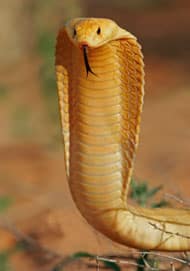Description:
Of variable coloration, the dangerously venomous cape cobra may be russet, mahogany, olive-brown, of any one of several shades of yellow to almost black. There is often a profusion of darker speckles or flecks on the lighter colored snakes. The snake has a broad hood. The venom is very potent. If challenged the snake may hiss loudly. A hatchling or juvenile cape cobras can be kept in terraria of 20 to 50 gallon capacity. An adult will require a minimum of a 50 gallon capacity terrarium and larger is better. The terrarium should be well ventilated and have a foolproof locking top. This snake will readily accept a small hidebox with a locking door (called a trapbox), easing the moving of the snake when the occasion arises. The trapbox will be most readily and continuously accepted if it is located in a quiet area of the cage. Sturdy, well anchored, horizontal climbing limbs are usually readily used. To facilitate the handling of this dangerous snake the cage design should be simple but effective. Captives will often remain fully hooded while a keeper is visible. Certainly, once the snake is in its trapbox the careful closing and locking of the door and then the moving of the box is the safest of all methods. Barring that, the use of a clamp stick is the next safest method. The cape cobra is usually easily manipulated on a snake hook. If you are new to the keeping of elapine snakes seek the help of an experienced elapine keeper. A temperature gradient of several degrees should be provided. At the cool end of the terrarium a temperature of 74 degrees Fahrenheit is suitable but the warm end should be 84 to 86 degrees. A basking hotspot of 94 to 100 degrees will be utilized during thermoregulation. Cypress, fir, aspen chips or bark shards are excellent choices for a substrate. After locking your cobra in its trapbox, feces can be removed with a small, long handled shovel. A large water bowl (kept scrupulously clean) should always be provided. The snakes will both drink, and if the receptacle is large enough, soak in the bowl. Keeping your snake well hydrated and its cage humidity fairly high, will help assure complete, healthy sheds. The cape cobra has very high metabolism. The snake will prowl actively when hungry. It will require feeding two or three times a week. Hatchlings should be fed pinky mice. As the snake grows, the size of the prey items should increase. Cape cobras are active year around. It is probable that climatic cues such as photoperiod, ambient temperature and relative humidity stimulate ovulation. This oviparous snake produces between 8 to 22 eggs in a clutch.
Habitat:
An arid land species, the cape cobra is often encountered along watercourses.
Range:
This is a species of Southern Africa
Scientific Name: Naja nivea
Species Group: venomous
Family: Elapidae
Size: About 5½ feet
Level: advanced
Weight:
Dangerous: No


